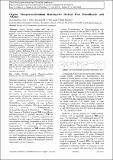Files in this item
Organo Phosphorus-Selenium Heterocycles Derived from Haloalkanols and Alkenes
Item metadata
| dc.contributor.author | Hua, Guoxiong | |
| dc.contributor.author | Fuller, Amy L. | |
| dc.contributor.author | Slawin, Alexandra M. Z. | |
| dc.contributor.author | Woollins, J. Derek | |
| dc.date.accessioned | 2014-08-11T14:01:02Z | |
| dc.date.available | 2014-08-11T14:01:02Z | |
| dc.date.issued | 2012-10 | |
| dc.identifier | 38586184 | |
| dc.identifier | 670d2c57-7c10-4691-945b-be83f6d7ee19 | |
| dc.identifier | 000309806400004 | |
| dc.identifier | 84866648904 | |
| dc.identifier.citation | Hua , G , Fuller , A L , Slawin , A M Z & Woollins , J D 2012 , ' Organo Phosphorus-Selenium Heterocycles Derived from Haloalkanols and Alkenes ' , Synlett , vol. 23 , no. 17 , pp. 2453-2458 . https://doi.org/10.1055/s-0032-1317310 | en |
| dc.identifier.issn | 0936-5214 | |
| dc.identifier.other | ORCID: /0000-0002-9527-6418/work/56861927 | |
| dc.identifier.other | ORCID: /0000-0002-1498-9652/work/31779214 | |
| dc.identifier.uri | https://hdl.handle.net/10023/5104 | |
| dc.description | Funding: University of St Andrews | en |
| dc.description.abstract | Treating Woollins' reagent with an equimolar amount of sodium 2-bromoalkanolates (which were prepared in situ from the reaction of bromoalkanol and NaH) in THF gave five- or six-membered PSeOCn (n = 2 or 3) phosphorus-selenium heterocycles 3 and 4 in good yields. Woollins' reagent reacting with one equivalent of conjugated 1,3-dienes led to the formation of different end products: with 1,4-diphenylbuta-1,3-diene giving a five-membered 2,3,5-triphenyl-4-styryl-1,2,5-selenadiphospholane 2,5-diselenide; however, with 2,3-dibenzyl-1,3-butadiene affording 4,5-dibenzyl-2-phenyl-3,6-dihydro-2H-1,2-selenaphosphinine 2-selenide as a major isolable product. Refluxing Woollins' reagent with one equivalent of unconjugated 2,5-dimethyl-1,5-hexyldiene in toluene produced P-Se heterocyclic compound 3-methyl-3-(3-methylbut-3-en- 1-yl)-2,5-diphenyl-1,2,5-selenadiphospholane 2,5-diselenide with the same five-membered C2P(Se)SeP(Se) motif as 2,3,5-triphenyl- 4-styryl-1,2,5-selenadiphospholane 2,5-diselenide. Further-more, heating a toluene solution of Woollins' reagent with an equimolar amount of N-allylaniline gave rise of a five-membered C2NP(Se)Se heterocycle 5-methyl-2,3-diphenyl-1,3,2-selenaza-phospholidine 2-selenide; carrying out a reaction of cinnamonitrile with an equivalent of Woollins' reagent under identical conditions did not give any air-stable product, however, 3-phenylprop-2-eneselenoamide was isolated in 95% yield after treatment with water. Three demonstrative X-ray structures are reported. | |
| dc.format.extent | 6 | |
| dc.format.extent | 746550 | |
| dc.language.iso | eng | |
| dc.relation.ispartof | Synlett | en |
| dc.subject | Woollin's reagent | en |
| dc.subject | Phosphorus-selenium heterocycle | en |
| dc.subject | Alkenes | en |
| dc.subject | Haloalkanonls | en |
| dc.subject | Selenoamide | en |
| dc.subject | QD Chemistry | en |
| dc.subject.lcc | QD | en |
| dc.title | Organo Phosphorus-Selenium Heterocycles Derived from Haloalkanols and Alkenes | en |
| dc.type | Journal item | en |
| dc.contributor.institution | University of St Andrews. School of Chemistry | en |
| dc.contributor.institution | University of St Andrews. EaSTCHEM | en |
| dc.identifier.doi | https://doi.org/10.1055/s-0032-1317310 | |
| dc.description.status | Peer reviewed | en |
This item appears in the following Collection(s)
Items in the St Andrews Research Repository are protected by copyright, with all rights reserved, unless otherwise indicated.

